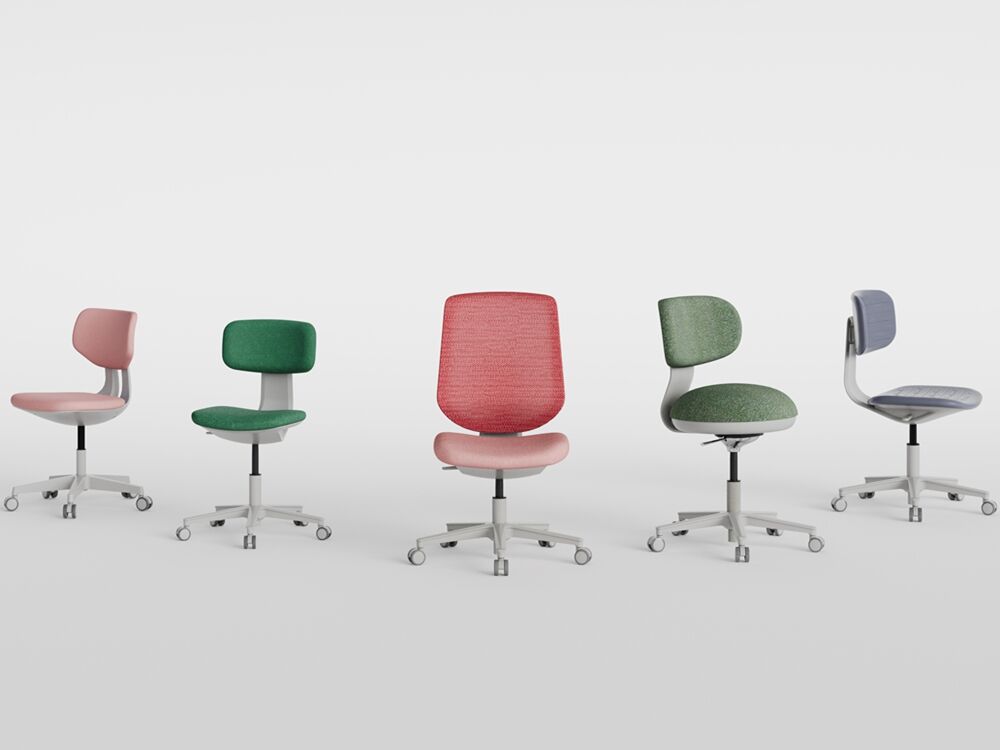
Design Elements of Modern Reception Chairs
Minimalist Aesthetics in Contemporary Design
Minimalist design in modern reception chairs has become a popular choice as it creates a clean and professional atmosphere, which appeals to today's corporate clientele. The simplicity and functionality of minimalist designs allow for a sophisticated look that does not overwhelm the space. Examples of popular minimalist reception chairs include the Eames Molded Plastic Chair and the Saarinen Executive Armchair, which are both known for their seamless blending of style and usability. Recent surveys indicate a rising preference for minimalist interiors in corporate environments, with 60% of businesses opting for such designs to enhance their workspace aesthetics and improve employee productivity (source: Interior Design Trends Study).
Color Trends for Professional Spaces
In professional settings, the psychology of color plays a significant role in shaping trust and professionalism. Blues and greys, which convey calmness and dependability, are popular choices for modern reception areas. Earth tones like beige and taupe are also gaining traction, creating a grounded and welcoming environment. Design experts suggest these colors enhance client perceptions and contribute to a positive workplace mood. According to a report by the American Society of Interior Designers, certain hues, like muted blue, can improve workspace efficiency by up to 15%, reinforcing the impact of color on both employees and clients.
Innovative Shapes for Visual Impact
Innovative shapes in reception chairs create a striking visual impact that can distinguish a brand in competitive markets. Companies now prefer chairs with unique forms such as angular backs or asymmetrical designs that not only ensure aesthetic appeal but also offer ergonomic comfort. For instance, the Knoll Womb Chair incorporates an unusual shape that supports a relaxed sitting posture while maintaining a dramatic look. Studies show that offices investing in such innovative designs report higher engagement and creativity among employees, as per data from the Business Design Journal, highlighting the importance of aesthetics in workplace strategy.
Ergonomic Considerations for Visitor Chairs
Lumbar Support and Posture Alignment
The importance of lumbar support in visitor chairs cannot be overstated, especially for maintaining health and comfort during prolonged visits. Lumbar support helps in aligning the spine and reducing the strain on lower back muscles, which is crucial for preventing back pain. Numerous studies have shown that ergonomic seating, which includes proper lumbar support, significantly reduces back pain in office environments. Features such as adjustable backrests, ergonomic seat designs, and cushioned lumbar padding are examples of ergonomic features that promote proper posture and alignment in reception chairs. Implementing these design elements in visitor chairs not only enhances comfort but also demonstrates a commitment to visitor well-being.
Adjustable Features for Diverse Users
Adjustable features in visitor chairs are vital for accommodating different body types and preferences, ensuring everyone finds comfort. Modern ergonomic office chairs often come with adjustable seat heights, armrests, and backrest recline options, all of which contribute to a more personalized seating experience. Such features provide exceptional comfort and can be particularly beneficial in environments with diverse visitors. According to industry data, there is a growing demand for adaptable office furniture, with evidence showing a direct correlation with increased satisfaction and productivity. Ensuring that visitor chairs include these adjustable features can significantly enhance user experience and satisfaction.
Breathable Materials for Extended Comfort
Breathable materials in visitor chairs play a crucial role in providing extended comfort by allowing for better airflow and temperature regulation. Materials such as mesh and moisture-wicking fabrics offer excellent breathability, ensuring that users remain cool and comfortable even during long waiting periods. While leather and faux leather materials provide a sophisticated aesthetic, they may lack optimal breathability. On the other hand, fabrics with moisture-wicking properties can prevent discomfort caused by sweat accumulation. User testimonials and expert opinions often highlight the importance of material selection for enhancing comfort, making breathable options a preferable choice for visitor seating.
Material Choices for Style and Function
Comparing Mesh vs. Fabric Upholstery
When it comes to choosing between mesh and fabric upholstery for office chairs, it's essential to consider factors like comfort, durability, and aesthetic appeal. Mesh upholstery offers excellent breathability, making it ideal for offices where users spend extended periods in seating. Its lightweight nature and modern look contribute to its popularity, with a trend towards minimalist and futuristic office designs. On the other hand, fabric upholstery provides a broader range of colors and textures, allowing for greater customization in office interiors. However, it may require more maintenance to prevent stains. Both types of upholstery have unique benefits, and their applicability often depends on the specific needs and style preferences of the office environment.
Leather Options for Premium Reception Areas
Leather office chairs bring a sense of luxury and sophistication, especially in high-end reception areas. Known for their durability and timeless appeal, leather chairs serve as a long-term investment with significant returns in aesthetic and functional terms. Maintenance varies depending on the leather type—full-grain leather ages well but requires regular conditioning; bonded leather offers a cost-effective alternative with easier upkeep but shorter lifespan. Insights from industry reports suggest that investing in premium materials like leather enhances the overall professional ambiance and can lead to positive client impressions, thereby indirectly contributing to business success.
Durability Factors in High-Traffic Spaces
Opting for durable materials in high-traffic areas is crucial to ensure chairs withstand daily wear and tear and provide prolonged service. Materials like reinforced metals for frames and high-grade polyethylene for components offer superior resistance to damage. Incorporating upholstery like performance fabric or tightly woven mesh can further enhance a chair's lifespan. Data indicates that businesses can achieve considerable cost savings by reducing frequent replacements, making durable office chairs a wise investment for commercial settings. Prioritizing durability not only saves costs but also maintains a polished, professional appearance in bustling office environments.
Space Optimization Strategies
Balancing Style and Practical Layouts
Achieving a balance between style and functionality in office reception areas is essential for creating a welcoming and efficient space. It's crucial to select furniture that not only complements the office's aesthetic but also optimizes spatial arrangements to enhance comfort and accessibility. Here are some strategies to achieve the right balance:
- Choose pieces that blend beauty with utility, such as ergonomic office chairs that offer comfort and are visually appealing.
- Arrange seating to promote ease of interaction, ensuring an inviting yet professional atmosphere. This can be achieved by placing chairs around central tables or in clusters to encourage conversation.
- Utilize space planning software—such as SketchUp or AutoCAD—to visualize different layouts and optimize the arrangement before investing in new furniture.
By strategically planning your layout and selecting furniture that marries style with practicality, you can create a reception area that reflects your brand while catering to the functional needs of your environment.
Modular Solutions for Flexible Spaces
Modular furniture offers a dynamic solution to crafting flexible and adaptive reception areas that can evolve with changing needs. Some of the primary benefits of modular setups include:
- Versatility: These pieces can be rearranged, added, or reduced to suit different spatial requirements or functions, making them ideal for dynamic office environments.
- Case Studies: Numerous organizations have successfully implemented modular furniture. For instance, tech firms often use modular solutions to encourage teamwork and collaboration, showcasing the strategic advantage of flexibility.
- Designs: Popular modular furniture designs like sectional seating or multi-functional tables blend aesthetic appeal with operational utility, providing cohesive yet adaptable solutions to optimize space usage.
Overall, by investing in modular furniture, businesses can efficiently cater to ongoing changes in employee interaction and space usage, ultimately facilitating a more personalized work environment that maintains an aesthetically pleasing appearance.
Branding Through Furniture Selection
Creating Lasting First Impressions
Furniture plays a pivotal role in forming positive first impressions in corporate environments. When visitors walk into a reception area, the furniture sets the tone for their entire experience, subtly communicating the company's ethos and attention to detail. Psychological research highlights how furniture aesthetics, such as color, shape, and arrangement, can significantly impact perception. For instance, an elegant and cohesive setup may evoke feelings of professionalism and reliability. Moreover, according to several industry reports, companies that invest in thoughtful furniture design experienced a notable improvement in brand image perception by their visitors. Choosing the appropriate office furniture not only enhances comfort but also sends a powerful brand message upon first glance.
Aligning Chair Design with Corporate Identity
Aligning furniture aesthetics with corporate branding is crucial for a cohesive identity. This involves selecting furniture that mirrors the company's brand colors, values, and mission, without compromising style or comfort. Incorporating brand elements such as logos and specific color palettes into furniture design allows for a seamless blend of style and corporate identity. Companies can utilize furniture to convey their uniqueness and foster a memorable visitor experience. A notable case study is Google, which has successfully integrated its playful and innovative corporate identity into its office spaces through vibrant and ergonomic furniture designs. This not only enhances their office aesthetics but also reinforces their brand reputation as a leader in innovation.










